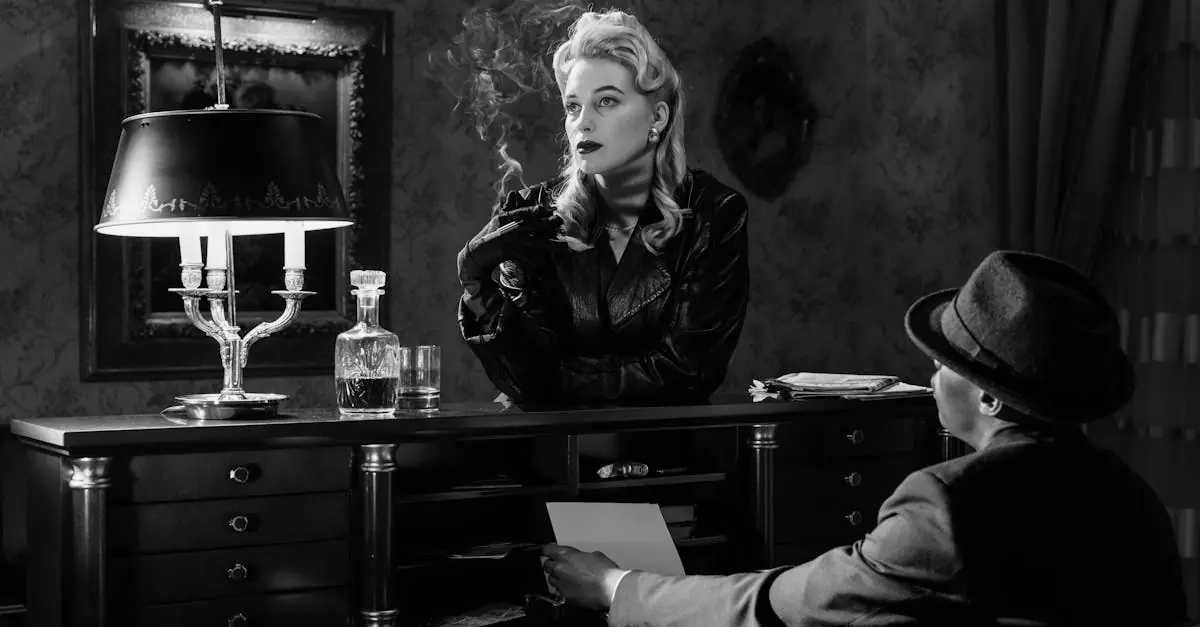Table of Contents
ToggleEvery great movie has a secret sauce that keeps audiences glued to their seats. Ever wondered what that magical ingredient is? Enter the movie plot diagram, the unsung hero behind captivating stories. It’s like the blueprint for a blockbuster, guiding filmmakers through rising action, climaxes, and those heart-pounding moments that leave viewers gasping for air.
Understanding the Movie Plot Diagram
The movie plot diagram plays a vital role in filmmaking. It visually outlines the progression of a story, enabling filmmakers to maintain clarity and focus throughout their narrative.
Definition and Importance
A movie plot diagram serves as a framework for storytelling. It illustrates the sequence of events and the emotional journey of characters. Understanding this diagram helps filmmakers create captivating narratives that resonate with audiences. Both novice and seasoned filmmakers benefit from utilizing a plot diagram during the development process. The structure encourages thorough planning and enhances storytelling techniques, ensuring consistent pacing and engagement.
Key Components of a Plot Diagram
Several key components form the foundation of a plot diagram. These include exposition, rising action, climax, falling action, and resolution. Exposition introduces characters and sets the scene, while rising action builds tension through conflicts. The climax marks the most intense point of the narrative, followed by falling action, which leads to resolution. Each of these components contributes to a well-rounded story, engaging viewers at every stage. Filmmakers must understand and effectively implement these elements to craft compelling cinematic experiences.
Stages of a Movie Plot Diagram
The stages of a movie plot diagram outline essential components that create a captivating story. Each segment builds upon the last, engaging viewers throughout the narrative.
Exposition
Exposition serves as the foundation of the plot. It introduces characters, settings, and initial conflicts, establishing the story’s context. For example, in “The Lion King,” the audience meets Simba in a vibrant African landscape, along with his father Mufasa and the challenge posed by Scar. This introductory phase helps viewers understand character motivations and relationships, providing clarity for what follows.
Rising Action
Rising action consists of events that escalate tensions and deepen conflicts. This stage reveals the protagonist’s struggles as they confront obstacles. In “Harry Potter and the Sorcerer’s Stone,” Harry faces challenges at Hogwarts, including rivalries with Draco Malfoy and the mystery of the Philosopher’s Stone. Tightly woven events propel the story forward, maintaining audience engagement and anticipation for the climax.
Climax
Climax represents the turning point of the plot, where tensions peak and conflicts reach their most intense moment. Key characters often face a significant decision or confrontation. In “Titanic,” the climax occurs when the ship hits an iceberg, prompting panic and chaos. This pivotal moment serves as the nexus for character development and narrative resolution, leaving audiences on the edge of their seats.
Falling Action
Falling action addresses the consequences of the climax, leading towards resolution. It presents the aftermath of the protagonist’s actions and decisions. For instance, in “The Dark Knight,” Gotham City grapples with the fallout from the Joker’s chaos. This segment showcases the characters processing their experiences, guiding viewers through the story’s emotional depths as conflicts begin to resolve.
Resolution
Resolution ties up loose ends and provides closure for the story. It reveals the outcomes of character arcs and themes. In “Toy Story,” Woody and Buzz restore their friendship, and the importance of teamwork becomes clear. This final stage connects the narrative’s individual threads, leaving audiences with a sense of fulfillment and understanding of the film’s deeper messages.
Examples of Movie Plot Diagrams
Movie plot diagrams manifest in diverse styles, as demonstrated by both classic and contemporary films. Below are examples that illustrate their application in storytelling.
Classic Films
Classic films exemplify the use of plot diagrams effectively. In “Casablanca,” the exposition presents key characters like Rick and Ilsa in a war-torn setting. The rising action unfolds through romantic tensions and moral dilemmas, leading to the climax where Rick’s pivotal choice emerges. Characters face consequences during the falling action, culminating in resolution where Rick embraces sacrifice for love. Such structured storytelling captivates audiences while ensuring emotional engagement.
Contemporary Films
Contemporary films continue to utilize plot diagrams for clarity. “Inception” showcases complex narratives with an intricate exposition introducing Dom Cobb and the dream-sharing technology. Rising action escalates as he assembles a team to infiltrate minds, culminating in a gripping climax during the multi-layered dream battle. Falling action reveals the aftermath of successful inception, with resolution focusing on Cobb’s return home. Through this structure, contemporary narratives maintain momentum and audience connection.
Benefits of Using a Movie Plot Diagram
Utilizing a movie plot diagram provides several advantages for filmmakers. Clarity emerges as a significant benefit, allowing creators to visualize the story arc and ensure each segment aligns with the intended narrative flow. Consistency enhances engagement, keeping audiences invested from the beginning to the end.
Planning becomes more efficient with a plot diagram in place. Filmmakers can easily identify potential pacing issues and adjust accordingly. Each stage of the diagram, such as rising action and climax, helps maintain audience interest and emotional connection throughout the film.
Creativity flourishes when using a plot diagram. It offers a structured approach, enabling filmmakers to explore unique ideas within a well-defined framework. The diagram also encourages collaboration among team members by providing a shared reference point for discussions.
Analyzing past films through a plot diagram reveals patterns in successful storytelling. By examining classic movies like “Casablanca” and contemporary films such as “Inception,” filmmakers can gain valuable insights into effective narrative strategies. This analysis leads to better decision-making during the writing process.
Feedback improves with the use of a plot diagram. Filmmakers can present the diagram to peers or test audiences, making it easier to gather constructive criticism and refine the story. Adjustments based on feedback contribute to a stronger final product.
Lastly, a movie plot diagram supports audience comprehension. When filmmakers effectively outline narratives, viewers can better follow character journeys and emotional arcs. This clear structure ensures that movies resonate on a deeper level, ultimately enhancing the overall viewing experience.
Understanding the movie plot diagram is essential for any filmmaker aiming to create captivating stories. By employing this framework, they can effectively structure their narratives and maintain audience engagement. Each stage of the plot diagram plays a vital role in guiding the emotional journey of characters and ensuring a coherent flow of events.
With clarity and consistency at the forefront, filmmakers can explore their creativity while refining their storytelling techniques. The insights gained from utilizing a plot diagram not only enhance the planning process but also foster collaboration among team members. Ultimately, a well-crafted plot diagram serves as a powerful tool that elevates cinematic experiences and resonates deeply with viewers.




